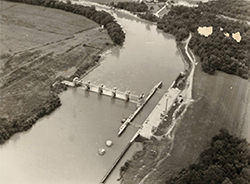 The Federal Government completed construction of the New Savannah Bluff Lock and Dam in 1937 for the authorized purpose of commercial navigation. Commercial navigation ceased along the Savannah River in 1979 and the lock and dam was subsequently moved into caretaker status in 1985. Federal funding was curtailed. Over time, the structure atrophied significantly. Cracks several feet deep have grown in the spillway piers. The lock wall filling is badly worn resulting in a cessation of lock operations in 2014. Erosion continues to cause loss of lateral support on the downstream side of the lock and additional problems continue to emerge. In 1999, the Corps’ Savannah District initiated a study, authorized under Section 216 of the Flood Control Act of 1970, to determine the Lock and Dam’s ability to function in a satisfactory manner and fulfill its federally-authorized purpose of supporting commercial navigation. The study concluded that the lock and dam no longer served this purpose and because of its degradation, would require major, costly repairs to continue safe operation. The study’s report, in the best interest of federal taxpayers, recommended removal of the structure. The District released draft findings for public comment in 2000.
The Federal Government completed construction of the New Savannah Bluff Lock and Dam in 1937 for the authorized purpose of commercial navigation. Commercial navigation ceased along the Savannah River in 1979 and the lock and dam was subsequently moved into caretaker status in 1985. Federal funding was curtailed. Over time, the structure atrophied significantly. Cracks several feet deep have grown in the spillway piers. The lock wall filling is badly worn resulting in a cessation of lock operations in 2014. Erosion continues to cause loss of lateral support on the downstream side of the lock and additional problems continue to emerge. In 1999, the Corps’ Savannah District initiated a study, authorized under Section 216 of the Flood Control Act of 1970, to determine the Lock and Dam’s ability to function in a satisfactory manner and fulfill its federally-authorized purpose of supporting commercial navigation. The study concluded that the lock and dam no longer served this purpose and because of its degradation, would require major, costly repairs to continue safe operation. The study’s report, in the best interest of federal taxpayers, recommended removal of the structure. The District released draft findings for public comment in 2000.
Local officials objected to the recommendation due to the incidental recreational and water supply benefits derived from the pool behind the dam by the surrounding communities. Congress passed legislation in 2000, with subsequent amendments in 2001, directing the Corps to discontinue its Section 216 analysis and to refrain from providing a final recommendation to Congress. This legislation also authorized the Corps to rehabilitate the lock and dam at federal expense and transfer ownership to local authorities. However, no funds were received for the rehabilitation of the structure.
Around this time the lock and dam became indirectly connected with the Savannah Harbor Expansion Project (SHEP). The harbor expansion was predicted to impact the endangered shortnose sturgeon, and was therefore required to mitigate this impact. Since mitigation for this species could not be accomplished within the footprint of the Savannah Harbor, federal and state natural resource officials proposed the inclusion of a fish passage at the New Savannah Bluff Lock and Dam as part of the SHEP because the lock and dam also impacted shortnose sturgeon by blocking the species access to its historical spawning grounds. Since civil works projects in the 1930s were constructed without environmental mitigation, the impacts to sturgeon were not addressed as part of the lock and dam project. Nevertheless, impacts could be mitigated for both SHEP and the lock and dam by enabling sturgeon to pass upstream of the 1930s structure. Therefore, since legislation from 2001 prevented divestiture of the lock and dam, a feature of SHEP included the construction of a fish passage around the structure.
The WIIN Act legislation in December 2016 addressed the dilemma of building a fish passage around a structure that is no longer viable. The legislation directed a solution that recognized and secured the pool while solving the problem posed by the dilapidated structure. The lock and dam would be removed and replaced by a fixed structure or modified to allow for the passage of fish while maintaining a pool for upstream water supply and recreation.
For details on this process and the way forward, click here.